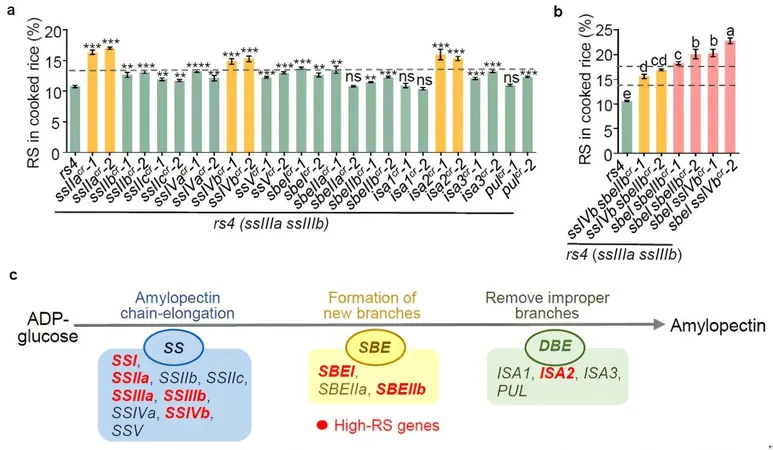
Breakthrough in Rice Genetics: Scientists Develop High-Resistant Starch Rice to Combat Diabetes and Obesity
2024-11-25
Author: Nur
Introduction
In a remarkable scientific advancement, researchers have unveiled a new variety of rice that boasts a significantly higher level of resistant starch (RS), a complex carbohydrate that could revolutionize dietary options for millions grappling with diabetes and obesity. Traditionally, most rice cultivars contain less than 2% resistant starch, making them less effective in aiding weight management and reducing blood sugar levels. However, recent studies indicate that through ingenious genetic modifications, this figure can be drastically improved.
Research Overview
A team of scientists, led by Wang Anqi from Professor Li Jiayang’s group at the Institute of Genetics and Developmental Biology under the Chinese Academy of Sciences, has confirmed that specific mutations in amylopectin biosynthetic genes can notably elevate the RS content. Their groundbreaking research, published in the Plant Biotechnology Journal on November 19, highlights the significant potential for enhancing the nutritional profile of rice.
Significance of the Study
Professor Li emphasized the importance of understanding the mechanisms behind RS biosynthesis, stating, "This work has crucial theoretical and practical implications for enhancing the nutritional value of rice, which is a dietary staple for so many people worldwide."
Historical Context
Historically, previous studies conducted by this research team demonstrated that alterations in single and double mutant strains of ssIIIa and ssIIIb could increase RS levels to 6% and 10%, respectively. In their latest investigation, the researchers utilized advanced genome editing techniques to analyze 14 genes involved in amylopectin biosynthesis, revealing that targeted mutations could yield an astonishing RS content exceeding 18% in certain quadruple mutant strains, particularly "sbeI sbeIIb ssIIIa ssIIIb" and "sbeI ssIVb ssIIIa ssIIIb."
Challenges and Prospects
However, there is a notable trade-off: as the RS levels surged, the overall grain yield and cooking quality of rice diminished. This presents a challenge for agricultural scientists, who must navigate the balance of optimizing both health benefits and palatability. Fortunately, the ssIIIa ssIIIb mutant has emerged as a promising candidate, maintaining a more equitable balance between RS augmentation and yield.
Conclusion and Future Directions
This revolutionary breakthrough not only sparks hope for healthier eating options but also positions rice breeders and geneticists at the forefront of combating global health crises linked to obesity and diabetes. As the interest in functional foods continues to rise, these innovations could change the landscape of agricultural practices and nutritional strategies for years to come.
Stay tuned as we continue to follow the developments of this scientific advance and its implications for healthier diets worldwide!


 Brasil (PT)
Brasil (PT)
 Canada (EN)
Canada (EN)
 Chile (ES)
Chile (ES)
 España (ES)
España (ES)
 France (FR)
France (FR)
 Hong Kong (EN)
Hong Kong (EN)
 Italia (IT)
Italia (IT)
 日本 (JA)
日本 (JA)
 Magyarország (HU)
Magyarország (HU)
 Norge (NO)
Norge (NO)
 Polska (PL)
Polska (PL)
 Schweiz (DE)
Schweiz (DE)
 Singapore (EN)
Singapore (EN)
 Sverige (SV)
Sverige (SV)
 Suomi (FI)
Suomi (FI)
 Türkiye (TR)
Türkiye (TR)